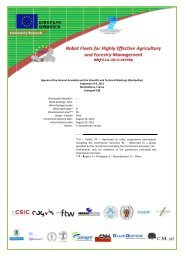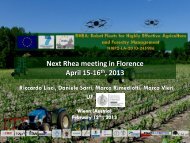1st Workshop BOOK - project RHEA
1st Workshop BOOK - project RHEA
1st Workshop BOOK - project RHEA
Create successful ePaper yourself
Turn your PDF publications into a flip-book with our unique Google optimized e-Paper software.
Camera System geometry for site specific treatment in precision agriculture<br />
Hyperspectral imagery to discriminate weeds in wheat<br />
Gilles Rabatel*, Farida Ougache**, Nathalie Gorretta* and Martin Ecarnot***<br />
�<br />
*UMR ITAP – Cemagref Montpellier<br />
361, rue J-F Breton, BP 5095 – 34196 Montpellier Cedex 5, France<br />
(e-mail: gilles.rabatel@ cemagref.fr)<br />
**Université Montpellier II, place Eugène Bataillon<br />
34095 Montpellier cedex 5, France<br />
***UMR AGAP - INRA Montpellier<br />
2 PLACE VIALA, 34060 Montpellier cedex 1, France<br />
Abstract: The problem of weed and crop discrimination by computer vision<br />
remains today a major obstacle to the promotion of localized weeding practices.<br />
The objective of present study was to evaluate the potential of hyperspectral<br />
imagery for the detection of dicotyledonous weeds in durum wheat during weeding<br />
period (end of winter). An acquisition device based on a push-broom camera<br />
mounted on a motorized rail has been used to acquire top-view images of crop at a<br />
distance of one meter. A reference surface set in each image, as well as specific<br />
spectral preprocessing, allow overcoming variable outdoor lighting conditions. The<br />
spectral discrimination between weeds and crop, obtained by PLS-DA, appears<br />
particularly efficient, with a maximal error rate on pixel classification lower than<br />
2%. However complementary studies addressing robustness are still required.<br />
1. Introduction<br />
The Precision Agriculture concept relies on the spatial modulation of crop<br />
processing operations, for a better adaptation to heterogeneities inside the parcel.<br />
This concept, which raised more than twenty years ago, is now currently applied in<br />
nitrogen input management, allowing a better control on yield and product saving.<br />
However, for weeding operations, despite considerable environmental and<br />
economical issues, the common practice until now is still to apply an assurance<br />
strategy: herbicides are uniformly spread all over the parcel whatever is the actual<br />
level of infestation.<br />
The reason is mainly technological. Actually some devices are proposed on the<br />
market to operate localized spraying of herbicides on bare soil (the vegetation<br />
35




